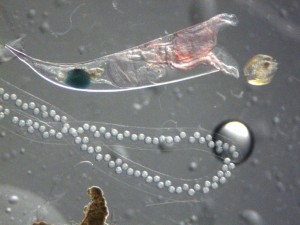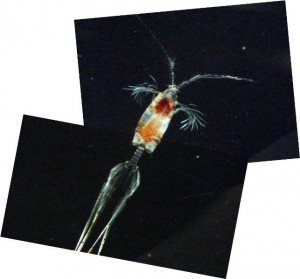
Kat Allen (not a sea monster) after a successful plankton tow, heading back to the lab with a container of zooplankton.

Getting ready to view zooplankton under the microscope. Fresh zooplankton are often more colorful than preserved zooplankton. The preservatives we use to bring them home to study often causes the animals to loose their bright blue, green and yellow color. Having the opportunity to study them freshly captured is a real treat – allowing us to observe them in their close to natural state – how they look in the water, how they swim and how they react to light and shadows.

Getting ready to view the animals under the microscope. At the top, there is a pteropod that has eaten some copepods (look for the blue eggs). To the upper right is a live ostracod – you may only have seen them as closed shells, but they actually contain miniature crustaceans. A string of salp eggs looks like a pearl necklace. In the lower left corner is a part of a polychaete worm (photobomb!)

Sometimes we even catch fish in the nets as well. This fish is not a sea monster, it is actually called a hatchet fish, a deep sea dweller that has large eyes to see in the dark. This is actually a larval fish that is about 3 cm long, about 1/3 of it is the head at this stage.

One of the largest copepods in the ocean, Euchaeta sp., can be found in abundance in our samples. It is easy to find, because it carries a large set of blue eggs. Check out the dish picture and see if you can find one.

This funny looking animal is a pteropod, a type of mollusk (similar to a snail). The winglike structures protruding from its glass-like shell allow it to move through the water like a bird flapping its wings.

Not all things we find in the net are obviously animals. This small group of spherical shapes is actually a single-celled animal called a foraminiferan (“foram” is the nickname of this cute little blob).

One of the more unusual crustaceans we have been finding are these stomatopods, notable for having eyes that are on stalks that stand out from its head, looking out for hatchet fish probably.

Sometimes the copepods have ornamentation (feather like appendages) that cannot fit into one picture. These feathery tufts help the copepod to maintain its position in the water column and to avoid predators by pretending to be twice as long.
- Jarrod Scott and Adelaide Rhodes

Are you expecting to find more interesting sea animals any time soon?
We did see Sperm Whales out way to far to get a photos, but we could watch their water spouts across the horizon. Keep an eye out, if we see them and get a picture, we will post it!!!
Hi dad or Mr.Tuorto
If I was on that ship with you I would be sad of how little books you have.
Are you able to see the zooplankton?
Now this is Charlotte T. What books do you like best.
Dear Mr. Tuorto,
What have you caught on the cruise?
Do you catch different things when
you are in different depths of the ocean?
Hello Abby,
I have caught lots of bacteria and phytoplankton! I catch them on filters. In this pictures you can see the difference between a clean filter and one that has microbes on it.
And the organisms big and small are different at each of the depths. That is one of the things I am studying on the samples from this cruise, what are the different microbes at each spot and depth of the ocean, and what are they doing?
Thanks,
Mr. Tuorto
Dear Mr. Tuorto,
How will you make the bacteria grow?
Hello Philip,
We make bacteria grow by feeding them! Bacteria basically need the same types of nutrition as we do. Our bodies break down large things, like hamburgers, down into smaller molecules in our digestive systems so that we can use them. Bacteria can only eat things after they are broken down into those tiny pieces (what we call dissolved), so that is how we feed it to them.
Thanks for the question,
Steve Tuorto
Hi dad I love and miss you .oh and nice pic
Of you in the immersion suit!!
Love Payton
how is your life on the boat
Hi Jaden,
Life on the boat is a lot of work and very tiring, but it is also like a fantastic adventure!
Thanks for the question,
Steve
Dear Steven,
What is your favorite thing to do on in your free time on the boat?
Hello Riley,
Believe it of not, even after seeing nothing but ocean for 9 days, my favorite thing to do in my free time was to watch the ocean. I could sit for ever to keep watch for schools of flying fish, or to just look at the horizon. I guess the ocean is just in my blood.
Thanks for interacting with us,
Steve
Do you have a lot of free time on the boat?
Do you spend a lot of time researching or working on projects more
Hello Riley,
Actually, our research is our projects, there are just many parts to them. Some times we are collecting, sometimes we are running an experiment, sometimes we are analyzing data, and sometimes we are writing about our results. There is never a dull moment!
Do you have people to research and people for other jobs and projects aboard?
how is it on the cruise????????????????????????? -_-
is it fffuuunnn???